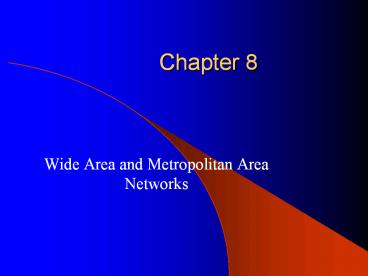Wide Area and Metropolitan Area Networks PowerPoint PPT Presentation
1 / 36
Title: Wide Area and Metropolitan Area Networks
1
Chapter 8
- Wide Area and Metropolitan Area Networks
2
Learning Objectives
- Describe the topologies used in wide area
networks and metropolitan area networks - Explain the use of IBMs System Network
Architecture and how it relates to todays
communication environments - Define System Application Architecture and how it
is used in a wide area network
3
Learning Objectives
- Describe the use of Digital Network Architecture
(DNA) - Illustrate the differences among the layered
architectures of SNA, SAA, DNA and the OSI model - Explain the concepts of electronic commerce and
business-to-business initiatives
4
Learning Objectives
- Explain how electronic data interchange (EDI)
uses wide area networks - Describe the use of metropolitan area networks in
the corporate environment
5
Introduction
- Wide area networks connect remote devices
- Global networks are becoming more important
- Metropolitan area networks connect servers and
clients in an area the size of a large city
6
Network Connections
- Point-to-Point Connections
- Local connection between server and client
7
Network Connections
- Point-to-Point Connections
- Local connection between server and client
- Client and remote server
8
Network Connections
- Point-to-Point Connections
- Local connection between server and client
- Client and remote server
- Computer to computer (server to server)
9
Network Connections
- Point-to-Point Connections
- Local connection between server and client
- Client and remote server
- Computer to computer
- Multipoint Connections
- Modem and/or concentrator used
10
Network Connections
- Point-to-Point Connections
- Local connection between server and client
- Client and remote server
- Computer to computer
- Multipoint Connections
- Modem and/or concentrator used
- Less costly than point-to-point
11
Topologies
- Wide Area Networks
- Hierarchical Networks
12
Topologies
- Wide Area Networks
- Hierarchical Networks
- Star Networks
13
Topologies
- Wide Area Networks
- Hierarchical Networks
- Star Networks
- Ring Networks
14
Topologies
- Metropolitan Area Networks
- Bus
15
Topologies
- Metropolitan Area Networks
- Bus
- Ring
16
Systems Network Architecture
- IBM product initially used for mainframe-to-mainfr
ame connections - Now used more extensively for many types of
network connectivity
17
Systems Network Architecture
- Advanced Program-to-Program Communication (APPC)
- Allows peer-to-peer communication between
programs - Also known as LU 6.2
18
Systems Application Architecture
- Set of standards that defines a common set of
user interfaces and communications systems for
many types of IBM computers
19
Systems Application Architecture
- Common User Access
- Common Programming Interface
- Common Communication Support
- The SAA Layered Model
20
Digital Network Architecture
- DECnet Support
21
Digital Network Architecture
- DECnet Support
- DNA Structured Model
22
Digital Network Architecture
- DECnet Support
- DNA Structured Model
- EnVISN Architecture
23
Electronic Commerce
- e-Commerce removes traditional boundaries
- Secure servers
- Business-to-business e-commerce is much larger
than business-to-consumer e-commerce
24
Data Warehousing
- Practice of keeping historical data available for
easy access - Data mining
- Used when fast access to vast quantities of data
is extremely important
25
Business-to-Business (B2B) Initiatives
- Supplier/Consumer relationships
- Alliances with competitors
- Use of extranet to share information
26
Electronic Data Interchange
- Exchange of documents by direct
computer-to-computer connection
27
Electronic Data Interchange
- Exchange of documents by direct
computer-to-computer connection - Without EDI, more manual intervention is
required, which slows processing time
28
Electronic Data Interchange
- Components of EDI
29
Electronic Data Interchange
- Components of EDI
- EDI Standards
- ANSI X.12
30
Electronic Data Interchange
- Components of EDI
- EDI Standards
- ANSI X.12
- Advantages of EDI
31
Metropolitan Area Network Implementations
- MAN Layered Architecture
32
Metropolitan Area Network Implementations
- MAN Layered Architecture
- Municipal MAN
33
Metropolitan Area Network Implementations
- MAN Layered Architecture
- Municipal MAN
- School District MAN
34
Summary
- WANs used to connect computers, terminals, LANs
- Point-to-point versus multipoint connections
- Topologies
- SNA designed for WANs by IBM
- DNA is Digital Equipments layered architecture
35
Summary
- Electronic commerce is growing rapidly
- Data warehousing allows easy access to large
amounts of data - EDI connects suppliers and customers via WANs
- Metropolitan area networks bridge the gap between
WANs and LANs
36
EndChapter 8

